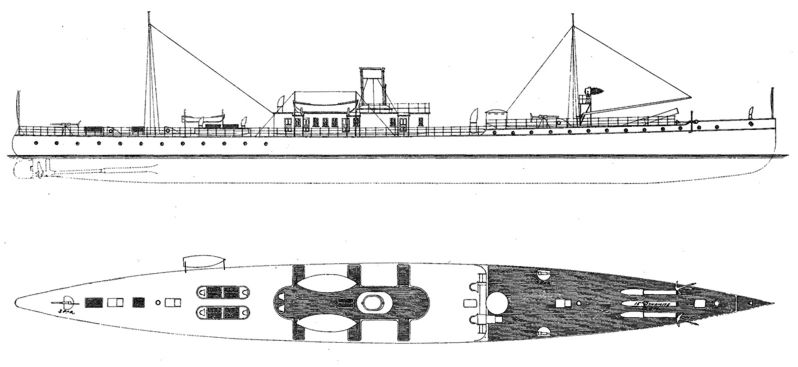Click On Image
For Full Size Image |
Size |
Image Description |
Contributed
By And/Or Copyright |

ves00 | NR | MIGHTY WAR VESSELS.
Launch of a Dynamite Cruiser and the Gunboat Yorktown.
A New Era Began in American Naval History.
There have been many launches of big and little ships, iron and -wooden, in years gone by at Cramp's shipyard, in Philadelphia, but never in the history of the city was so much excitement created as the dual launch on Saturday of the dynamite cruiser Vesuvius and the gunboat Yorktown. What made it particularly notable was that it is the first launching for years of a war vessel there, that there were two ships to slide into the water and that Congress "would be in town" to witness the event.
At noon the excursion steamer Columbia, Captain George Tyler, lay at the pier at the foot of Washington street, adjacent to the old Navy Yard of blessed memories. She had been chartered by the Secretary of the Navy to convey his Congressional party from the cars to Cramp's yard. The steamer was gayly decked out in bunting, and after receiving her cargo of distinguished people, took up a good position in view of the event.
Strange to say, on the Columbia there were fifty members of the House of Representatives, which was three more than is necessary for a quorum.
At three o'clock the Yard Superintendent reported everything ready for the launch and Mr. Charles Cramp gave the command, with the consent of the Secretary of the Navy, to "Let go the breaks" of the Yorktown. Whack, whack, sounded the mauls as the men struck the chunks away, and just as this big iron hull began to slide riverward Miss May Cameron, daughter of Senator Cameron, of Pennsylvania, whacked the gunboat over her nose with a bottle of champagne, held by red, white and blue ribbons. It broke and as the wine spilled all down over the ship's rigid iron and paint, this lovely girl said: "I baptize thee Yorktown." The Yorktown began to move at six and a half minutes past three o'clock, and floated gracefully on the Delaware within a minute.
Hardly had the excitement over the first event subsided when it broke out afresh over the dynamite cruiser, which lay on its ways, near the place the Yorktown had left. Miss Eleanor Breckinridge, daughter of Congressman Breckinridge of Kentucky, performed the christening function for the dynamite cruiser, as Miss Cameron had for the gun boat. As she broke the bottle over her bow this Blue Grass belle exclaimed, "I baptize thee Vesuvius." This was indeed news to even the Secretary's intimate friends, as he had kept it a secret till, at the last moment, he handed Miss Breckinridge his official order to call the cruiser Vesuvius. The Vesuvius gilded graceful on her element four minutes after the Yorktown. | Image and text provided by University of North Carolina at Chapel Hill Library, Chapel Hill, NC.
Photo from Fisherman & Farmer. [volume] (Edenton, N.C.) 1887-19??, 11 May 1888, Image 6, via chroniclingamerica.loc.gov. |
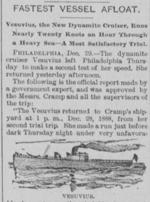
ves15 | NR | FASTEST VESSEL AFLOAT.
Vesuvius, the New Dynamite Cruiser, Runs
Nearly Twenty Knots an Hour Through
a Heavy Sea, A Most Satisfactory Trial. | Image and text provided by University of Delaware Library, Newark, DE.
Photo from Evening Journal. [volume] (Wilmington, Del.) 1888-1932, 29 December 1888, Image 1, via chroniclingamerica.loc.gov. |
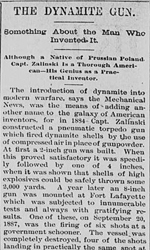
ves16 | NR | THE DYNAMITE GUN
Vesuvius, the New Dynamite Cruiser, Runs
Nearly Twenty Knots an Hour Through
a Heavy Sea, A Most Satisfactory Trial.
The introduction of dynamite into modern warfare, says the Mechanical News, was the means of adding another name to the galaxy of American inventors...... |
Image and text provided by Library of Virginia; Richmond, VA.
Photo from The Roanoke Times. [volume] (Roanoke, Va.) 1890-1895, 29 May 1892, Image 2, via chroniclingamerica.loc.gov. |

c0402 |
555k |
USS Philadelphia (C 4), center playing her searchlights on USS Alarm, at left, and USS Vesuvius, at right. Water by Fred S. Cozzens, 1892, published as a chromolithograph in Our Navy Its Growth and Achievements, 1897. U.S. Naval History and Heritage Command Photograph. |
Source Collection: NH 74552 via history.navy.mil
|
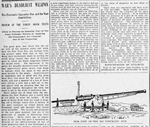
ves17 | NR |
WAR'S DEADLIEST WEAPON
The Pneumatic Dynamite Gun and Its Vast Possibilities. |
Image and text provided by University of Nebraska-Lincoln Libraries, Lincoln, NE.
Photo from Omaha Daily Bee. (Omaha [Neb.]) 187?-1922, 02 September 1894, Part III, Image 20, via chroniclingamerica.loc.gov. |
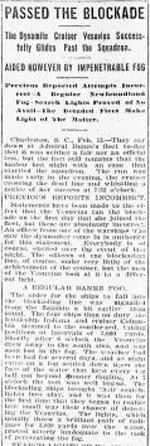
ves22 | NR | The Dynamite Cruiser Vesuvius Successfully Glides Past the Squadron.
They say down at Admiral Bunce's fleet today that it was neither a fair nor an official test, but the tact still remains thai the harbor last night with an ease that startled the squadron. The run was made early in the evening, the cruiser crossing the dead line and whistling a notice of her success at 7:32 o'clock.... |
Image and text provided by Library of Virginia; Richmond, VA.
Photo from The Norfolk Virginian. [volume] (Norfolk, Va.) 186?-189?, 14 February 1897, Image 1, via chroniclingamerica.loc.gov. |
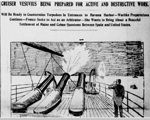
ves20 | NR | U. S. CRUISER VESUVIUS THROWING DYNAMITE SHELLS & BEING PREPARED FOR ACTIVE AND DESTRUCTIVE WORK.
While all the other ships in the navy are receiving much attention just now, and their work and merits are discussed, one of the most powerful ships, and one that would be put to fighting at once if war broke out, has had little said about her. And that is the famous dynamite cruiser Vesuvius. Having been bottled up in St. John's river for nearly a year, engaged in the exercise of watching for filibusters, a sort of Spanish police boat, as she is often styled here, she has almost been forgotten. But recent events show that the authorities in Washington have their eyes upon her. Much activity has recently been shown upon the vessel, and some curiosity has been manifested as to the reason. It is known that the dynamite guns are in need of repair, that the officers have been working night and day to get them in first-class shape again. It seems that the trouble is in a set of air valves controlling the loading of the guns with condensed air. In some way a careless machinist used a file on some of the finest valves, and the valves leak so that the guns are hampered.
All the crew have received their battle stations, and drill at quarters is now a common thing night and day. Drill with the three sinister-looking dynamite tubes making their noses up forward through the fore deck like gigantic cigars is going on the while, and the men are very expert in manning them. These guns can be fired together. They have a range of three or four miles with light charge, and from one and half to two miles with the heavy load, striking within 40 yards of any object aimed at... |
Image and text provided by Rhode Island Digital Newspaper Project.
Photo from The Evening Tribune, (Pawtucket, R.I.), 189?-190?, 21 March 1898, Image 1, via chroniclingamerica.loc.gov. |
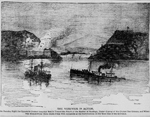
ves18 | NR |
THE VESUVIUS IN ACTION.
On Tuesday Night the Dynamite Cruiser Vesuvius Ran in Toward the Mouth of the Harbor of Santiago, Under Convoy of the Cruiser New Orleans, and When a Mile Distant Fired Three Shells Filled With Dynamite at the Fortifications on the West Side of the Entrance. |
Image and text provided by University of California, Riverside; Riverside, CA.
Photo from The San Francisco Call. [volume] (San Francisco [Calif.]) 1895-1913, 16 June 1898, Image 3, via chroniclingamerica.loc.gov. |
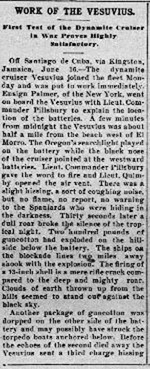
ves19 | NR | WORK OF THE VESUVIUS.
First Test of the Dynamite Cruiser in War Proves Highly Satisfactory Off Santiago de Cuba.
The dynamite cruiser Vesuvius joined the fleet Monday and was put to work immediately. Ensign Palmer, of the New York (ACR 2), went on board the Vesuvius with Lieut. Commander Pillsbury to explain the location of the batteries. A few minutes from midnight the Vesuvius was about half a mile from the beach west of El Morro. The Oregon's (BB 3) searchlight played on the battery while the black nose of the cruiser pointed at the westward batteries. Lieut. Commander Pillsbury gave the word to fire and Lieut. Quimby opened the air vent. There was a slight hissing, a sort of coughing noise, but no flame, no report, no warning to the Spaniards who were hiding in the darkness. Thirty seconds later a dull roar broke the silence of the tropical night. Two hundred pounds of guncotton had exploded on the hillside below the battery. The ships of the blockade lines two miles away shook with the explosion. The firing of a 13-inch shell is a mere rifle crack compared to the deep and mighty roar. Clouds of earth thrown up from the hills seemed to stand out against the black sky. Another package of gun cotton was dropped on the other side of the battery and may possibly have struck the torpedo boats anchored below. Before the echoes of the second died away the Vesuvius sent a third charge hissing out. It fell right on the brow of the hill where the battery seemed to lie. Into the air flew tons of earth and the smoke covered the land for half a mile. The Vesuvius retired at a 16-knot rate. Two flashes from the hill and two Spanish shells flew beyond the cruiser. The test is regarded as highly satisfactory and there is intense interest in the fleet over this first trial in war of a dynamite cruiser. |
Image and text provided by Louisiana State University; Baton Rouge, LA.
Photo from Le Meschacebe.1853 - 1942?, 25 June 1898, Image 3, via chroniclingamerica.loc.gov. |

ves23 | NR | THE DYNAMITE CRUISER VESUVIUS IN ACTION.
Firing Dynamite Projectiles at the Fortifications at Santiago de Cuba Harbor.
Inset photo of John E. Pillsbury, Lieutenant Commander, USN, of USS Vesuvius. |
Image and text provided by University of Kentucky, Lexington, KY.
Photo from The Bourbon News., [volume] (Paris, Ky.) 1895-19??, 05 July 1898, Image 2, via chroniclingamerica.loc.gov. |
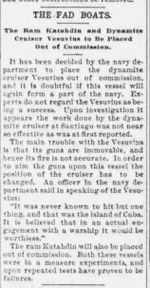
ves27 | NR | THE FAD BOATS.
The Ram Katahdin and Dynamite Cruiser Vesuvius will likely be placed out of commission.
It has been decided by the navy department to place the dynamite cruiser Vesuvius out of commission, and it is doubtful if this vessel will again form a part of the navy. Experts do not regard Vesuvius as being a success. Upen investigation it appears the work done by the dynamite cruiser at Santiago was not nearly as effective as was at first reported.
The main trouble with the Vesuvius is that its guns are immovable, and hence its fire is not accurate. In order to aim the guns upon this vessel the
position of the cruiser has to be changed. An officer In the navy department said in speaking of the Vesuvius: "It was never known to hit but one thing, and that was the island of Cuba. It is believed that in an actual engagement with a warship it would be worthless."
The ram Katahdin will also be placed out of commission. Both these vessels were in measure experiments, and upon repeated tests have proven to be failures. |
Image and text provided by University of Kentucky, Lexington, KY.
Photo from Daily Public Ledger. [volume] (Maysville, Ky.) 1892-191?, 15 September 1898, Image 4, via chroniclingamerica.loc.gov. |
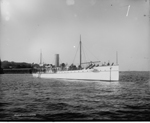
ves08 |
961k |
The USS Vesuvius taken sometime between 1890 and 1901.
Source Collection: Detroit Publishing Company photograph collection via via the Library of Congress
|
Bill Gonyo |
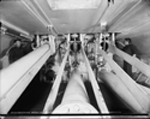
ves21 |
1.09k |
The USS Vesuvius breeches of dynamite guns, taken sometime between 1890 and 1901.
Reproduction Number LC-DIG-det-4a13994. Source Collection: Detroit Publishing Company photograph collection via (Library of Congress)
|
Library of Congress |
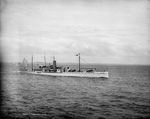
ves09 |
984k |
Starboard broadside of the USS Vesuvius (Dynamite Cruiser) underway
at an unknown location. Photo dates between 1890-1901.
Library of Congress, LC-D4-21047
|
Mike Green |
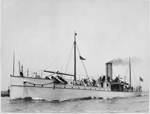 |
2.76k |
Port bow underway, 1891. Image # (19-A-2-87) |
National Archives |
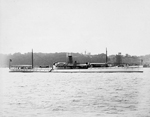
ves14 |
393k |
The Dynamite Cruiser USS Vesuvius at New York, during the Columbian Naval Parade, 27 April 1893. Photographed by Loeffler (1864-1946).
Image courtesy of DeGolyer Library, Southern Methodist University |
Robert Hurst |
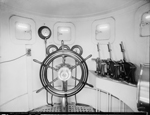
ves05 |
914k |
Interior of the USS Vesuvius conning tower located behind the
dynamite guns. |
Source Collection: Detroit Publishing Company photograph collection via (Library of Congress)
|
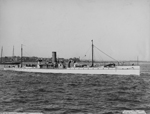
ves04 |
1.26k |
Interior of the USS Vesuvius out for a cruise along with similar landscape in other photos (New York City?) |
Source Collection: history.navy.mil
|
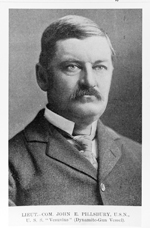
ves26 |
382k |
John E. Pillsbury, Lieutenant Commander, USN, of USS Vesuvius, during Spanish-American War, 1898. |
Source Collection: NH 72750 via history.navy.mil
|
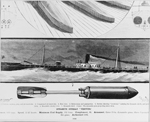
ves24 |
2.51k |
Broadside exterior view of and the dynamite shell of the dynamite Gunboat USS Vesuvius.
Authorized 1886 Vol 45 Jan-June, 1898, Scientific American. |
Source Collection: NH 123824 via history.navy.mil
|
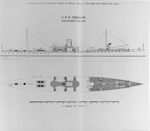
ves25 |
766k |
Unofficial plans USS Vesuvius |
Source Collection: NH 70120 via history.navy.mil
|

ves03 |
433k |
Sailors row a cutter away from the USS Vesuvius. Note man in boat's stern holding flagstaff with 13 star ensign. Stereo print. |
Source Collection: NH 93706 via history.navy.mil
|
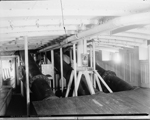
ves12 |
1.05k |
Interior of the USS Vesuvius barrels of dynamite guns, 1886 and 1901.
Reproduction Number LC-DIG-det-4a13992
Source Collection: Detroit Publishing Company photograph collection via (Library of Congress)
| Bill Gonyo
|
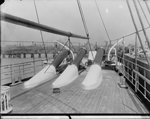
ves06 |
1.41k |
Vesuvius carried three 15-inch (38-cm) cast iron pneumatic guns,
mounted forward side-by-side at a fixed elevation of 16 degrees. Gun
barrels were 55 feet (17 meters) long with the muzzles 15 feet (4.6
meters) above the deck 37 feet (11 meters) abaft the bow. In order to
train these weapons, the ship had to be aimed, like a gun, at its target.
Compressed air from a 1000 psi (70 atm) reservoir projected the shells
from the "dynamite guns." Two air compressors were available
to recharge the reservoir.
Source Collection: Detroit Publishing Company photograph collection via (Library of Congress)
|
Bill Gonyo |
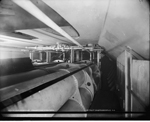
ves11 |
1.08k |
Interior image of the USS Vesuvius (Dynamite Cruiser) showing
projectile carriers for the three guns. Photo dates from 1809-1901.
Source Collection: Detroit Publishing Company LC-D4-2011, photograph collection via Library of Congress
|
Mike Green |
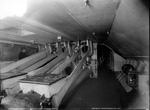
ves10 |
227k |
Interior image of the breeches of the dynamite guns of the USS Vesuvius
(Dynamite Cruiser). Photo dates from 1890-1901.
Library of Congress, LC-D4-20113
|
Mike Green |
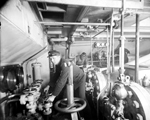
ves07 |
1.02k |
USS Vesuvius air chambers for the dynamite guns. The shells
fired from the guns were steel or brass casings 7 feet (2 meters) long
with the explosive contained in the conical forward part of the casing
and spiral vanes on the after part to rotate the projectile. The explosive
used in the shells themselves was actually a "desensitized blasting
gelatin" composed of nitrocellulose and nitroglycerine. It was
less sensitive to shock than regular dynamite but still sensitive enough
that compressed air, rather than powder, had to be utilized as the propellant.
Shells containing 550 pounds (250 kg) of explosive had a maximum range
of 1 mile (1.6 km), but range could be extended to 4000 yards (3.7 km)
by reducing projectile weight to 200 pounds (100 kg). Maximum muzzle
velocity was 800 feet (250 meters) per second. Range could be reduced
by releasing less compressed air from the reservoir. Ten shells per
gun were carried on board, and 15 shells were fired in 16 minutes 50
seconds during an 1889 test. The shells employed an electronic fuse
which could be set to either explode on contact or delayed to explode
underwater.
Photo courtesy of the Library of Congress
|
Bill Gonyo |
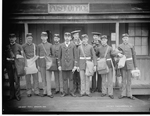
ves02 |
1.16k |
"Philadelphia Navy Yard" on right mailbag; USS Vesuvius" on cap of third man from right. |
Source Collection: Detroit Publishing Company photograph collection via (Library of Congress)
|
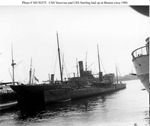
ves13 |
527k |
USS Vesuvius and USS
Sterling laid up at Boston Naval Shipyard, circa 1900.
U.S. Naval Historical Center Photograph #NH 90373.
|
Mike Green |

ves28 | NR | THE STORM SEASON-DEATH DEALING DERELICTS.
It is not conducive to the repose of those "who go down to the sea in ships and do business on the deep waters" to know that scores of derelicts are floating aimlessly about the two great oceans, mostly in the Atlantic, some of them in the direct highways of maritime commerce; yet very few sailors ever give the subject a thought. In the capital of our country, however, there is a body of men whose duty it is not only to obtain information of these dreadful menaces to navigation, but if possible to exactly locate them, chart their routes and supply such information as will lead to their removal.....
However, the Vesuvius would be of inestimable value as a wreck destroyer, and it is to be hoped that she will at once be dispatched on her beneficent mission in search of the derelicts......They have been approximately located and are constantly sketched. it would not be a difficult matter for the Vesuvius to find some of them at least and by sending them to "Davy Jones locker" with a charge of dynamite clear the minds of hundreds of brave tars, who have less fear of the derelicts as such than of their phantom crews on the lookout for companions in theireerie voyagings. |
Image and text provided by Kansas State Historical Society; Topeka, KS.
Photo from The Topeka State Journal. [volume] (Topeka, Kansas) 1892-1980, 01 January 1901, Image 5, via chroniclingamerica.loc.gov. |
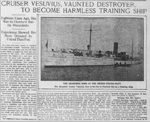
ves29 | NR | CRUISER VESUVIUS VAUNTED DESTROYER TO BECOME HARMLESS TRAINING SHIP
Eighteen Years Ago She Was to Overturn Battle Precedents.
Experience Showed Her More Dreaded by Friend Than Foe.
THE ANARCHIST BOMB OF THE UNITED STATES NAVY
The Dynamite Cruiser Vesuvius Now to Be Put to Practical Use as a Training Ship. |
Image and text provided by Library of Congress, Washington, DC.
Photo from The Washington Times. [volume] (Washington [D.C.]) 1902-1939, 12 June 1904, Magazine Features, Image 28, via chroniclingamerica.loc.gov. |
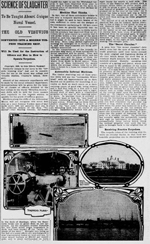
ves30 | NR | SCIENCE OF SLAUGHTER
To Be Taught Aboard Unique Naval Vessel.
THE OLD VESUVIUS CONVERTED INTO A MODERN TORPEDO TRAINING SHIP.
Will Be Used for the Instruction of Officers and Men in How to Operate Torpedoes.
Distinctly unique in our navy is the "torpedo training ship". Just put in commission for use at the naval war college and torpedo station, Coaster's Island, in Narragansett Bay, Newport, Rhode Island...
Receiving Practice Torpedoes.
The torpedo tubes of the training ship revolve on circular tracks, so that their automobile projectiles can be discharged.
In the days of Santiago, when the Spaniards broke out in goose flesh at her approach. As the dynamite cruiser Vesuvius she has these seven years languished in dock, and been known as the "white elephant of the navy." Brought into being as the fad of a naval officer, she was designed to sow concentrated hades on land and sea, to clear mined harbors at $90,000 per square mile, and to plant earthquakes on terra firma, wherever she might design. Fated from the first to be unique, she was the only dynamite boat in any navy. But today, after an expenditure of $200,000, about all that remains of her old self are her hull and engines, and even these are entirely new in many parts..... |
Image and text provided by Library of Congress, Washington, DC.
Photo from Evening Star. [volume] (Washington, D.C.) 1854-1972, 24 June 1905, Image 19, via chroniclingamerica.loc.gov. |
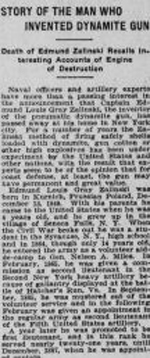
ves31 | NR | STORY OF THE MAN WHO INVENTED DYNAMITE GUN |
Image and text provided by University of California, Riverside; Riverside, CA.
Photo from Los Angeles Herald. [microfilm reel] (Los Angeles [Calif.]) 1900-1911, 16 April 1909, Image 10, via chroniclingamerica.loc.gov. |

ves32 | NR | VESUVIUS TEARS HOLE IN HERSELF
Struck by One of Her Own Torpedoes and Beached - Patched Up Later. |
Image and text provided by University of Vermont.
Photo from Burlington Weekly Free Press. [volume] (Burlington, Vt.) 1866-1928, 22 May 1913, Image 6, via chroniclingamerica.loc.gov. |
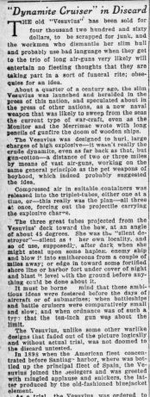
ves33 | NR | Dynamite Cruiser in Discard
THE old Vesuvius has been sold for four thousand two hundred and sixty dollars, to be scrapped for junk, and the workmen who dismantle her slim hull will probably use bad language when they get to the trio of long air-guns very likely will entertain no fleeting thoughts that they are taking part in a sort of funeral rite; obsequies for an idea....
About a quarter of a century ago, the slim Vesuvius was launched and heralded in the press of this nation, and speculated about in the press of other nations, as a new naval weapon that was likely to sweep from the seas the current type of war-craft, even as the Monitor and the Merrimac wrote with long pencils of gunfire the doom of wooden ships....
The Vesuvius was designed to hurl, large charges of high explosive—it wasn’t really the crude dynamite, even as far back as that, but gun-cotton—a distance of two or three miles by means of vast air-guns, working on the same general principle as the pet weapons of boyhood, which indeed probably suggested the idea.......In fact, when Santiago fell and an examination was made it was learned that the fearsome blast from the modern Vesuvius had scarcely scarred the ancient walls, and had not harmed the old fortress or displaced the aged bronze guns in their embrasures. “Sound and fury, signifying nothing,” was the verdict on the Vesuvius and the slender “Dynamite Cruiser” came back from the war in considerable disrepute...
And now, after a couple of dozen years, most of the time on the retired list, the old Vesuvius has been mid as junk to a dealer named Lipsitz, of Chelsea, Mass. — as junk, the pretty cruiser that was designed to junk the rest of the navies of the world by its launching of a new idea in marine warfare.
But the stodgy workmen won’t think of that, junking the Vesuvius, and probably swearing a bit as they toil over the heavy tubes that once let loose a blast for Old Glory against the grim gray walls of Morro Castle. |
Image and text provided by Digital Library of Georgia, a project of GALILEO located at the University of Georgia Libraries.
Photo from Atlanta Tri-Weekly Journal. [volume] (Atlanta, Ga.) 1920-19??, 02 May 1922, Image 4, via chroniclingamerica.loc.gov. |
